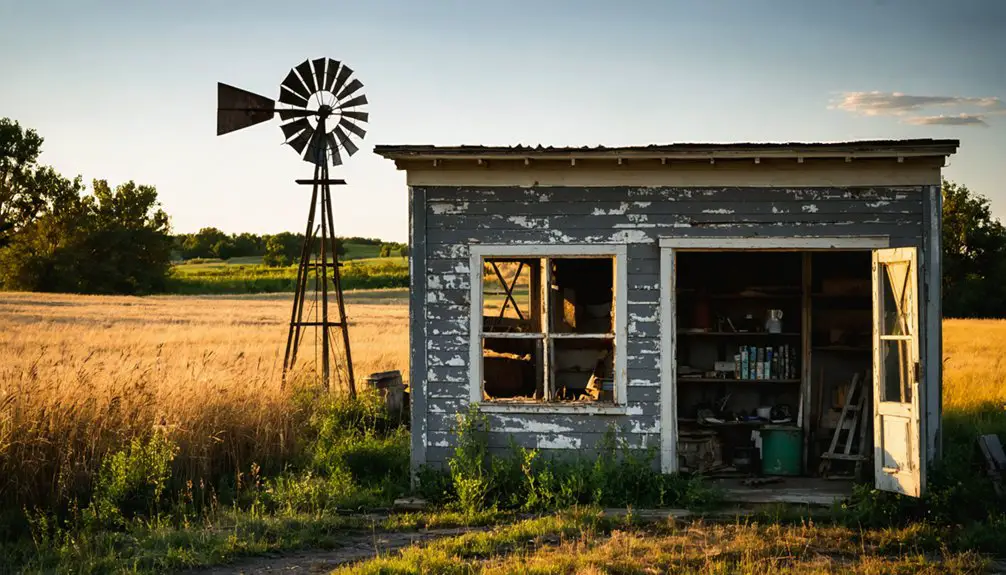You’ll discover Cave Springs nestled along the historic Santa Fe Trail, where Dr. E.H. Long established a promising health resort town in 1873. His 64-block grid design centered around a natural limestone cave and mineral springs, attracting settlers with claims of therapeutic waters. The town flourished briefly with a post office, stores, and essential services until its decline in the early 1900s. Today, Mount Zion Cemetery‘s 485 graves hold the stories of this vanished Kansas settlement.
Key Takeaways
- Cave Springs was founded in 1873 by Dr. E.H. Long as a health resort town centered around therapeutic mineral springs and caves.
- The town flourished with businesses including stores, a post office, and hotels, attracting settlers due to its location near the Santa Fe Trail.
- Natural limestone caves and mineral-rich springs were promoted for healing properties, treating ailments like rheumatism and skin conditions.
- The town’s decline began in the 1890s due to skepticism about healing waters, leading to its official dissolution on April 2, 1949.
- Mount Zion Cemetery, with 485 interments, remains as the last physical remnant of the ghost town and serves as a historical record.
The Birth of a Health Resort Dream
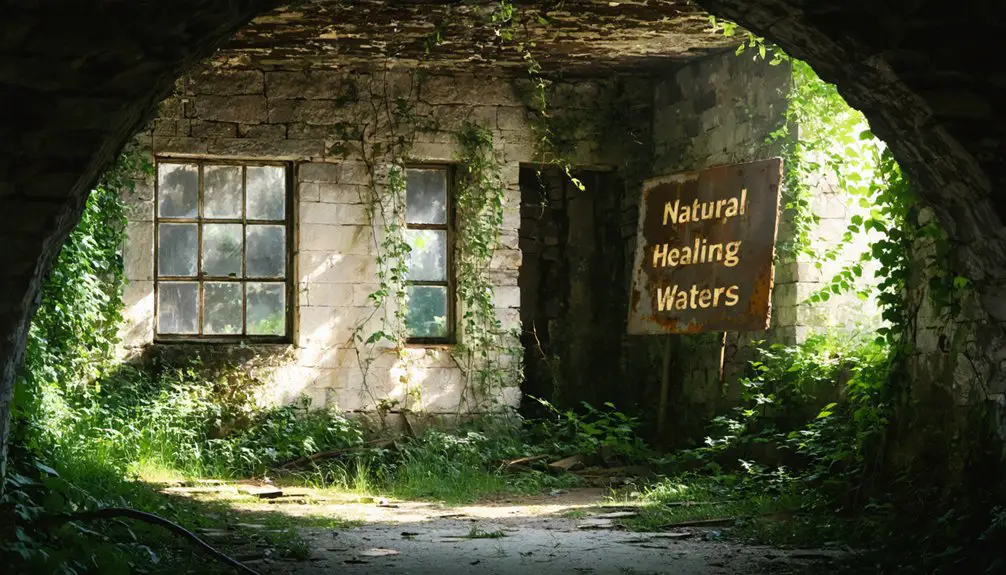
When Dr. E.H. Long surveyed the pristine landscape of Elk County in 1873, you can bet he saw more than just a cave with flowing springs – he envisioned a thriving health tourism destination.
The 80-acre property’s natural features, particularly the overhanging rock formation and its reliable springs, became the cornerstone of his ambitious plan.
You’ll find that Long, more promoter than physician, wasted no time advertising the springs’ supposed healing properties in Eastern newspapers.
Similar to Arkansas’ Sulphur Springs resort, the site attracted visitors seeking medicinal benefits from the mineral-rich waters.
He carefully plotted 64 blocks for development, keeping the prime real estate containing the springs and hotel for himself.
The community dynamics quickly took shape as businesses sprouted up – from a ten-room hotel to a weekly newspaper office – all supporting Long’s vision of a complete health resort town.
A daily hackline service transported visitors between Howard and Fall River, ensuring guests could easily reach the promising health destination.
Dr. Long’s Vision and Town Planning
The methodical blueprint of Cave Springs emerged through Dr. E.H. Long’s entrepreneurial spirit in 1873 when he acquired 80 acres in Elk County.
You’ll find his vision reflected in the carefully planned 64-block grid that would shape the community infrastructure of this health resort town. Similar to modern developments like the single-point urban interchange being constructed today, the town required careful planning for traffic flow.
- Long retained Block 27, protecting the cave and springs that were central to his therapeutic vision
- Block 28 was reserved for a hotel to accommodate health-seeking visitors
- Streets and alleys were meticulously mapped to support organized growth
- The surrounding blocks were subdivided for sale to settlers and investors
- Commercial and residential zones were strategically positioned around the natural attractions
Though the town ultimately vanished, with only Mount Zion Cemetery remaining, Long’s ambitious 19th-century planning showcased how natural resources could anchor a thriving community‘s development.
Natural Wonders: The Cave and Springs
When you explore Cave Springs today, you’ll find a remarkable natural cave system formed by groundwater carving through limestone, creating an extensive solution channel that’s been drawing visitors since the Santa Fe Trail era.
The springs themselves became renowned for their mineral-rich waters, which local settlers believed held therapeutic properties for various ailments. The dense foliage near the moat makes the springs hard to locate for modern visitors.
The cave’s documented exploration history dates to the mid-1800s, with early pioneers using it both as a reliable water source and as shelter during their westward journeys along the trail. The area’s historical significance was recognized when Sylvia Mooney organized preservation efforts in 1975 to protect this natural landmark for future generations.
Geological Origins and Features
Situated within ancient Paleozoic bedrock dating back 280-500 million years, Cave Springs showcases dramatic karst formations carved from limestone and Gasconade dolomite.
As you explore this unique karst landscape, you’ll witness the power of acidic groundwater that’s sculpted an intricate underground world through mineral deposits and erosion. When rainwater absorbs carbon dioxide from the atmosphere and soil, it becomes slightly acidic water that gradually dissolves the carbonate rocks.
The Cave Limestone formations create deep ravines and steep ridges throughout the area, with numerous caves and crevices leading to springs.
- Natural caves formed as water dissolved the calcium-rich marine rocks, creating extensive passages and chambers
- Springs emerge at cliff bases where underground streams surface through solution-carved conduits
- Stalactites and stalagmites decorate cave interiors, built up over millennia from dripping mineral-rich water
- Fossil remains of ancient sea creatures like Spirifer cameratus and crinoids are preserved in the rock layers
- Sinkholes and solution openings dot the terrain, revealing the area’s complex subsurface drainage system
Springs’ Therapeutic Properties
During the late 1800s, Cave Springs gained prominence as a therapeutic destination after Dr. E.H. Long promoted its mineral waters as a natural remedy.
You’ll find that the spring’s therapeutic claims included treatments for rheumatism, neuralgia, liver problems, and various skin conditions. The waters’ mineral properties feature ions like lithium, barium, bromine, and strontium – similar to other Kansas springs known for their medicinal value. Similar to the Hot Springs National Park in Arkansas, Cave Springs offered therapeutic bathing options to visitors.
What made Cave Springs particularly appealing was its remarkably consistent flow, even during the severe drought of 1936. This reliability guaranteed steady access to mineral-rich waters for bathing and drinking. Ancient peoples including Egyptians and Greeks recognized the healing properties of mineral springs, establishing a long tradition of therapeutic use.
Like other American mineral springs that attracted health tourists, including those visited by President Roosevelt for polio relief, Cave Springs developed into a health resort where you could seek treatment for various ailments through systematic mineral water therapy.
Local Cave Exploration History
The natural cave formation that gives Cave Springs its name beckoned early settlers and explorers since its discovery in the 1870s.
Local cave exploration revealed a complex network of passages that captured the imagination of both scientists and adventurers. The cave’s significance grew as it served as a vital resting point for pioneers traveling along the Santa Fe Trail.
- Dr. E.H. Long first recognized the cave’s potential in the 1870s, establishing an 80-acre health resort around the natural wonder.
- The cave’s rediscovery during a 1948 church parking lot construction sparked renewed interest in local legends.
- KU scientists conducted extensive passage explorations mid-century, drawing significant media attention.
- Multiple passages varied in size, with some becoming impassable due to narrow widths or clay blockage.
- The cave’s spring exhibited remarkable stability, maintaining consistent flow even during the severe drought of 1936.
Life in Early Cave Springs
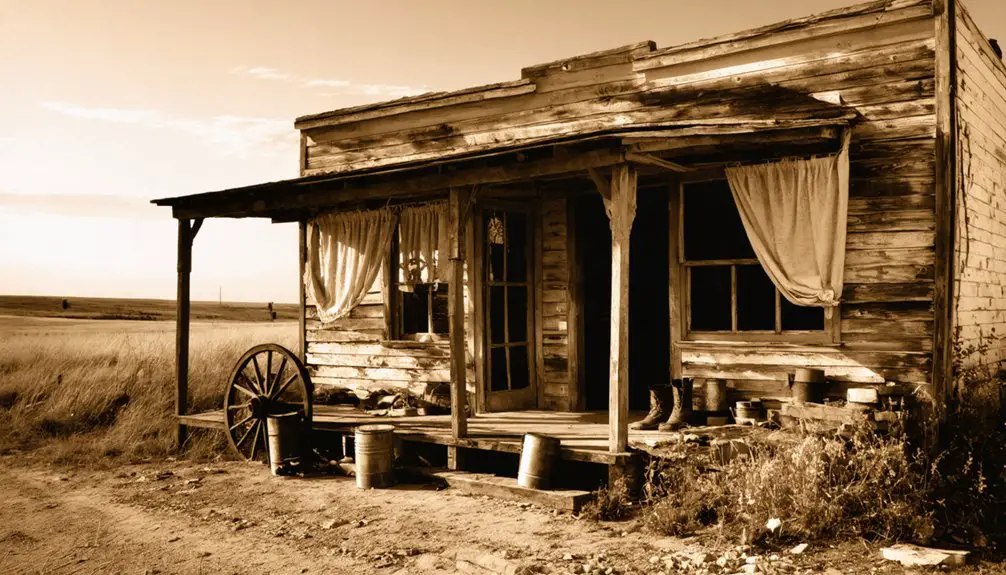
After its founding in 1873, Cave Springs quickly evolved from an untamed frontier outpost into a vibrant Kansas community, thanks largely to Dr. E.H. Long’s vision of establishing a health resort on his 80-acre property.
You’d have found yourself among settlers drawn to the town’s carefully planned 64 blocks, where social gatherings at the ten-room hotel’s dining hall became central to local traditions.
Daily life revolved around the bustling general store, grocery, and drug store, while the livery stable’s pool room offered entertainment in its loft.
You could’ve gotten a trim at the barber shop, browsed the millinery store, or caught up on news at the newspaper office.
The town’s prime location near the Santa Fe Trail brought a steady stream of travelers, contributing to its dynamic atmosphere.
The Post Office Era: 1873-1903
Alongside Cave Springs’ growing community life, 1873 marked the establishment of the town’s post office under the management of E.F. Reser. The post office’s significance extended far beyond mail services, becoming the heart of local commerce and community connections.
- Daily hacklines connected Cave Springs to neighboring towns, facilitating mail and passenger movement.
- The post office anchored other businesses, including the Cave Springs Globe newspaper and Long’s Hotel.
- Livery stables and feed stores thrived alongside postal operations, managing transportation needs.
- Local merchants, including druggists and real estate agents, operated near the post hub.
- Robert Moore & Co. supported mail routes and community transit services.
Though Cave Springs entered decline in the late 1880s, the post office remained steadfast until its closure in 1903, serving as one of the town’s final functioning institutions alongside the general store and blacksmith shop.
From Boom to Bust: The Decline
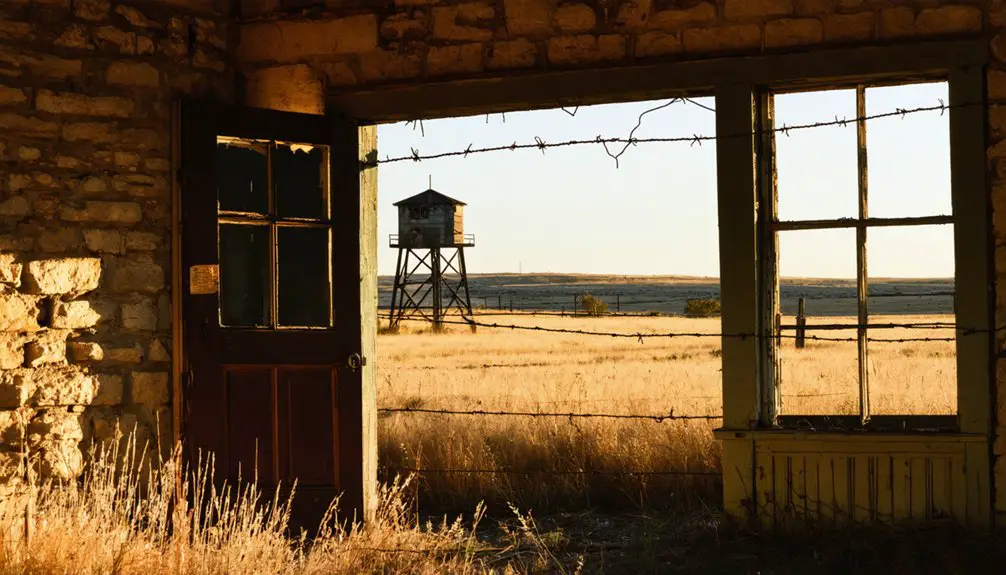
Once celebrated for its purportedly healing spring waters, Cave Springs experienced a dramatic reversal of fortune in the late 1880s. As skepticism grew about the springs’ healing properties, visitors dwindled, and the town’s economic resilience crumbled.
The departure of Dr. Long, who traded his holdings for Mississippi swampland, dealt a devastating blow to community engagement and local confidence.
You’ll find the town’s decline accelerated rapidly after 1890. Without steady visitor traffic, businesses shuttered and infrastructure deteriorated.
The springs and cave briefly served as manufacturing sites, but these efforts proved futile. The population scattered to more prosperous nearby towns, including Howard, nine miles southwest.
Legislative Actions and Town Dissolution
When Kansas Governor Frank Carlson signed legislation on April 2, 1949, Cave Springs’ original townsite in Elk County was officially vacated, marking the formal end of its municipal existence. The legislative impacts were far-reaching, dissolving all aspects of municipal governance and clearing the way for future land use without town obligations.
Cave Springs vanished from Kansas maps in 1949 when Governor Carlson’s signature officially dissolved the town’s municipal status.
- All streets and alleys were legally disestablished
- Land management responsibilities shifted to county control
- Public thoroughfares lost their official designation
- Town’s ability to enact ordinances ceased
- Municipal structures were completely dismantled
You’ll find that this action followed decades of decline, with the post office’s closure in 1903 signaling the town’s diminishing functions.
Today, only Mount Zion Cemetery (also known as North Pole Cemetery) remains as a cultural landmark, while the site’s recognition persists through historic records rather than legal status.
Mount Zion Cemetery Legacy
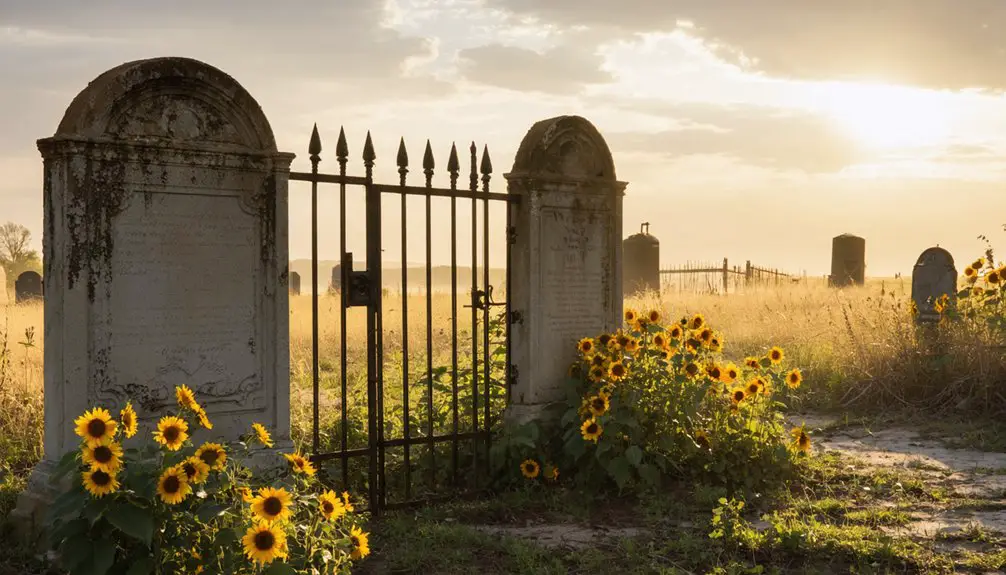
You’ll find Mount Zion Cemetery‘s earliest documented burial dates to 1862 with Caroline Elizabeth Jones, though the first surviving tombstones mark the 1875 graves of infants John H. Bagley and George W. Moran.
Today’s records reveal nearly 485 interments, making this cemetery the most tangible connection to Cave Springs’ past.
The cemetery’s diagonal row of Moran family markers stands out against the traditional north-south layout, reflecting the deep ties between prominent families and the development of early Elk County.
Historical Burial Records
Mount Zion Cemetery, also known locally as North Pole Cemetery, stands as the final physical remnant of Cave Springs’ vanished community, housing approximately 485 memorial records that tell the story of its earliest settlers.
You’ll find rich burial symbolism throughout the grounds, from lamb figures on children’s graves to detailed epitaphs that reveal the area’s cultural heritage.
- Find a Grave database provides digital access to detailed gravestone inscriptions
- Family plots document pioneer lineages, including the John J. Pauls and Gerhard Neufeld families
- Documented single graves of unknown persons highlight historical mysteries
- Weathered tombstones preserve personal epitaphs and causes of death
- Genealogical research links burial permits with county archive case files
These preserved records serve as your gateway to understanding Cave Springs’ community life before its legislative closure in 1949.
Community Memory Preservation
Beyond its burial records, the profound legacy of Cave Springs lives on through Mount Zion Cemetery‘s role as a communal touchstone.
You’ll find community narratives woven throughout the sacred grounds, from the diagonal alignment of Moran family graves to the clustering of pioneer family plots that tell stories of early settlement.
As Cave Springs’ last physical remnant, Mount Zion Cemetery stands as more than just a burial ground – it’s a living repository of ancestral connections.
The adjacent Bagley farm and preserved infant graves from 1875 speak to the deep roots of family ties.
Even after the town’s official vacation in 1949, local residents and genealogists have maintained this essential link to the past through persistent stewardship and digital preservation efforts, ensuring future generations can connect with their heritage.
Geological Significance
The limestone formations of Cave Springs reveal a complex geological story, dominated by the distinctive Spring Rock – a hard, bluish-gray limestone packed with marine fossils and calcite crystals.
Spring Rock’s bluish-gray limestone stands as nature’s archive, preserving ancient marine life within its crystalline walls.
You’ll find this unique karst topography shaped by water’s endless dance with rock, creating a landscape that’s both rugged and mesmerizing.
- Natural fractures in the limestone create angular fragments that weather distinctively
- Caves and sinkholes form where water erodes the softer, porous upper sections
- Springs emerge where permeable limestone meets less permeable shales
- Groundwater travels westward through rock layers before surfacing
- Ancient marine fossils like Spirifer cameratus tell of prehistoric seas
These geological features haven’t just shaped the land – they’ve determined where people could build, farm, and access water throughout Cave Springs’ history.
Preserving Cave Springs’ Memory
You’ll find Mount Zion Cemetery, also known as North Pole Cemetery, standing as the most tangible reminder of Cave Springs’ pioneer legacy.
The cemetery’s weathered headstones tell the stories of the town’s earliest settlers, including Dr. E.H. Long who founded the community in 1873 as a health resort.
Through careful documentation of burial records and family histories, local historians have preserved essential details about Cave Springs’ residents, ensuring their contributions to Kansas settlement aren’t forgotten.
Local Cemetery’s Lasting Legacy
Mount Zion Cemetery stands as the final physical remnant of Cave Springs, preserving the memory of this extinct Kansas settlement through its 485 memorial records.
You’ll find this historical preservation site at 2067 Rd 24a in Fall River, Kansas, where it serves as the last record of a once-thriving pioneer community.
- Functions as an essential genealogical resource for tracing local family histories
- Documents the area’s shift from settlement to ghost town since the 1870s
- Provides tangible links to early settler families through grave markers
- Serves as a focal point for heritage tourism and historical research
- Maintains cultural memory despite Cave Springs’ official vacation in 1949
The cemetery’s significance extends beyond its role as a burial ground – it’s now your gateway to understanding the rich pioneer heritage of southeast Kansas.
Documenting Pioneer Family Stories
Pioneer families who shaped Cave Springs’ early development left behind rich narratives that illuminate southeast Kansas’ settlement era. Through preserved letters, diaries, and guest accounts from the Cave Springs Hotel, you’ll discover pioneer anecdotes of Dr. E.H. Long’s health resort vision and W.C. Getty’s newspaper publishing endeavors.
Family legacies interweave throughout the community’s evolution, from the Glover family’s agricultural innovation to the Barnes and Chiles families’ influential landholdings. You can trace the entrepreneurial spirit of early settlers through stories of R.W. Rule’s real estate ventures and Robert Moore’s livery stable operations.
These documented accounts reveal how pioneer families established essential services, from the Montrose post office to the town’s first grocery stores, creating a vibrant frontier community.
Frequently Asked Questions
What Was the Maximum Population Ever Recorded in Cave Springs?
You won’t find a definitive maximum population in historical records, but given the town’s limited growth and early decline, experts estimate it likely never exceeded a few hundred residents.
Were Any Significant Archaeological Artifacts Found in the Cave System?
You won’t find documented evidence of major archaeological discoveries from cave exploration at this site, though the area’s archaeological significance remains largely unexplored through formal scientific surveys or excavations.
Did Any Famous People Besides Dr. Long Live in Cave Springs?
You’ll find several famous residents connected to these historical landmarks: Col. James Chiles served as a state legislator, Harry Truman’s grandfather owned property there, and Jesse Barnes was the influential original landowner.
What Businesses Operated in Cave Springs During Its Peak Years?
You’d have found historic establishments like a general store, grocery, drug store, doctor’s office, hotel, newspaper office, blacksmith shop, post office, millinery store, and local commerce including barber services.
Were There Any Documented Native American Settlements Near Cave Springs?
While Native tribes moved through the region, you won’t find direct evidence of settlements at Cave Springs itself. The closest documented Native presence was Cherokee activity at Beaver Dam during 1830s removal conflicts.
References
- https://legendsofkansas.com/cave-springs-kansas/
- https://en.wikipedia.org/wiki/Cave_Springs
- https://esirc.emporia.edu/bitstream/handle/123456789/1313/Richards Vol 5 Num 1.pdf?sequence=4
- https://www.wikiwand.com/en/articles/Cave_Springs
- https://www.kgs.ku.edu/Publications/Bulletins/ED9/Educational_Series_9.pdf
- https://www.vintagebentonville.com/benton-county-place-names.html
- https://mostateparks.com/sites/mostateparks/files/Cave Spring.pdf
- https://storymaps.arcgis.com/stories/d9577f4f22f443b88b4ff9e06b739492
- https://legendsofkansas.com/every-place-in-kansas-c/
- https://cavespringsvms.blob.core.windows.net/uploads/20256a36-59c8-4fdb-b8b8-6d3a14750f54-Cave_Springs_Vision_Plan_Draft_11.17.20_Appendix_Maps_Combined_RFS.pdf
